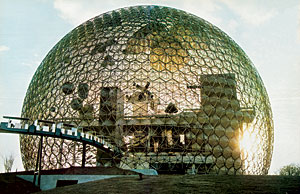
Fuller’s giant dome served as the U.S. Pavilion at Expo 67 in Montreal.
Co-curators Dana Miller and K. Michael Hays discuss their summer 2008 exhibition, Buckminster Fuller: Starting with the Universe, at the Whitney Museum of American Art in New York. They talk about the organization of the show, Fuller's 'geo-logical' approach to design, and his influence on contemporary architecture.
Bucky’s dome, by contrast was tensile and light, a gossamer thing with a synergetic structure that was virtually not there. It was Habitat turned inside out, a global enclosure with its particulars subsumed beneath its organizing whole, rather than aggregated to create the whole itself. If Habitat’s surfaces were meant to be awash with greenery, the breathing dome produced its own climate and grew its garden indoors. Into this space of potentiality, things were simply inserted — factories, “standard of living packages,” exhibitions, radars, airplanes.
The two projects were united, however, by one of the sturdiest tropes of Modernity, the idea that the conjunction of architecture, technology, and mass production had the potential to resocialize the project of building, to direct scientific efficiencies to redress the problem of shortage, especially of housing. For Safdie, the idea of those factory-built boxes shipped and stacked promised urban densities on the quick, in a form at once radical and familiar. But it was a heavy industrial vision, demanding massive investment and highly centralized organization.
Bucky’s lifelong quest for mass-produced housing came from another direction. His most innovative work along these lines — the series of prefab houses beginning with the 4D House (patented in 1928) and culminating in the Dymaxion Dwelling Machine (patented in 1946) — had as its predicate a winnowing of materials and a simplification of erection that had more to do with kit building than the assembly line. The entire Dymaxion house was to be shipped to its site in a big tube that contained all its elements, none of which weighed more than 10 pounds, allowing the whole thing to be put together in a few days by one person. Indeed, the weight of the house itself was a svelte 6,000 pounds, in contrast to a traditional house of similar size, tipping the scales at 300,000 pounds. Doing more with less was an abiding credo for Bucky but one that ramified far beyond the less-is-more aesthetic of Modernist minimalism. His genius at such paring down continues to secure his relevance.
In this preoccupation with the weight of things, from cars to planets, Bucky was concerned not simply with economy but with shortage. Although this commitment is sometimes derided as so much mystical palaver, Bucky was an authentic pioneer in the movement for global ecology: His career was dedicated to making global systems both legible and logical, to “reforming the environment, not reforming man.” This is clear throughout his copious — if often baroque — writing, as well as in the projects and research he inspired. One of the most important (and lucid) of these — still very much worth reading — is John McHale’s The Ecological Context, of 1969. Before he met Bucky, McHale was an artist and a leading light of the British Independent Group, described by Reyner Banham (also a member) as the “Father of Pop.” McHale’s interest in Fuller dated from the ’50s, part of his general fascination with the intersection of technology and culture and of his broader penchant for futurism. He joined Fuller at Carbondale in the ‘60s, participating in the massive World Resources Inventory project and eventually striking out as an extremely rigorous and pioneering analyst of global ecology, a bridge-builder — like Bucky — between spheres of knowledge and action.
I took another trip a little later in 1967 (this time without mom), to Haight Ashbury. It was, after all, the Summer of Love, and San Francisco was the place to be. One of the most commanding artifacts in the recent retrospective of Fuller’s work at the Whitney Museum was a film showing Bucky holding forth to a young crowd in Golden Gate Park at the height of those halcyon days. I never did hear one of Bucky’s marathon orations, but this tape gives a good hint at his mesmerizing power. There he sits, a gnomic, grandfatherly presence in a black three-piece suit and watch chain, among the flower children, entirely at home. It’s a question-and-answer session and Bucky is remarkably succinct, compassionate, persuasive, and smart. He bounces babies on his knee. His answers are satisfying, whether he dilates on the history of specialization, the pernicious character of the nation state, the need to turn global resources away from warfare and toward constructive activity, or questions of tetrahedral geometry, the formal quantum of the universe for Bucky. In every sense, this was a man thinking outside the box, gently drawing others along.
Although he was all the rage with the counterculture, Bucky has long had an ambiguous relationship to the architectural profession and its canon. It may be his polymathic project that engendered this; the comparison with Leonardo, whom nobody would simply call an architect, is apposite, if slightly generous. But Bucky surely has more in common with an Edison than a Mies: He was an inventor, mathematician, geometer, cartographer, ecologist, manufacturer, industrial designer, moralist, epistemologist, world systems thinker — a concatenation of abilities that sometimes produced architecture but found its way there through nonorthodox working methods and winding trains of thought. His architecture did not emerge from the profession’s traditions but developed as a series of consolidations of other approaches; architecture was a solution, not an objective.



Post a comment to this article
Report Abusive Comment